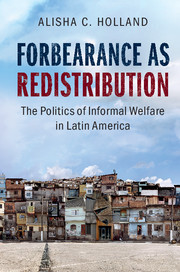Book contents
- Forbearance as Redistribution
- Cambridge Studies in Comparative Politics
- Forbearance as Redistribution
- Copyright page
- Contents
- Figures
- Tables
- Acknowledgments
- Introduction
- 1 An Electoral Theory of Forbearance
- 2 Who Votes for Forbearance
- 3 What Enables Forbearance
- 4 When Politicians Choose Forbearance
- 5 Where Forbearance Occurs
- 6 Why Forbearance Continues
- 7 How Forbearance Ends
- 8 Conclusion
- Book part
- References
- Index
- Other Books in the Series (continued from page ii)
- References
References
Published online by Cambridge University Press: 30 August 2017
- Forbearance as Redistribution
- Cambridge Studies in Comparative Politics
- Forbearance as Redistribution
- Copyright page
- Contents
- Figures
- Tables
- Acknowledgments
- Introduction
- 1 An Electoral Theory of Forbearance
- 2 Who Votes for Forbearance
- 3 What Enables Forbearance
- 4 When Politicians Choose Forbearance
- 5 Where Forbearance Occurs
- 6 Why Forbearance Continues
- 7 How Forbearance Ends
- 8 Conclusion
- Book part
- References
- Index
- Other Books in the Series (continued from page ii)
- References
- Type
- Chapter
- Information
- Forbearance as RedistributionThe Politics of Informal Welfare in Latin America, pp. 342 - 367Publisher: Cambridge University PressPrint publication year: 2017



